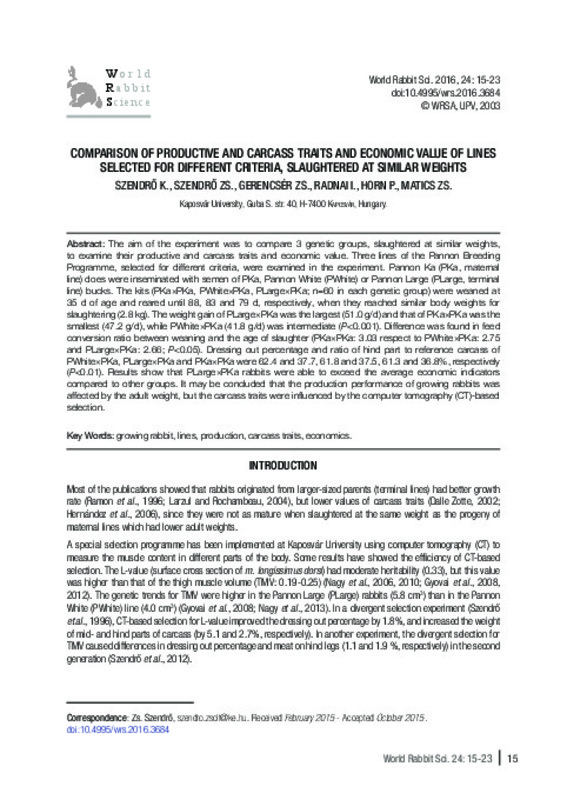JavaScript is disabled for your browser. Some features of this site may not work without it.
Buscar en RiuNet
Listar
Mi cuenta
Estadísticas
Ayuda RiuNet
Admin. UPV
Comparison of productive and carcass traits and economic value of lines selected for different criteria, slaughtered at similar weights
Mostrar el registro sencillo del ítem
Ficheros en el ítem
| dc.contributor.author | Szendrő, K.
|
es_ES |
| dc.contributor.author | Szendrő, ZS.
|
es_ES |
| dc.contributor.author | Gerencsér, ZS.
|
es_ES |
| dc.contributor.author | Radnai, I.
|
es_ES |
| dc.contributor.author | Horn, P.
|
es_ES |
| dc.contributor.author | Matics, ZS.
|
es_ES |
| dc.date.accessioned | 2016-09-14T13:24:16Z | |
| dc.date.available | 2016-09-14T13:24:16Z | |
| dc.date.issued | 2016-03-22 | |
| dc.identifier.issn | 1257-5011 | |
| dc.identifier.uri | http://hdl.handle.net/10251/69501 | |
| dc.description.abstract | [EN] The aim of the experiment was to compare 3 genetic groups, slaughtered at similar weights, to examine their productive and carcass traits and economic value. Three lines of the Pannon Breeding Programme, selected for different criteria, were examined in the experiment. Pannon Ka (PKa, maternal line) does were inseminated with semen of PKa, Pannon White (PWhite) or Pannon Large (PLarge, terminal line) bucks. The kits (PKa×PKa, PWhite×PKa, PLarge×PKa; n=60 in each genetic group) were weaned at 35 d of age and reared until 88, 83 and 79, respectively, when they reached similar body weights for slaughtering (2.8 kg). The weight gain of PLarge×PKa was the largest (51.0 g/d) and that of PKa×PKa was the smallest (47.2 g/d), while PWhite×PKa (41.8 g/d) was intermediate (P<0.001). Difference was found in feed conversion ratio between weaning and the age of slaughter PKa×PKa: 3.03 respect to PWhite×PKa: 2.75 and PLarge×PKa: 2.66; , P<0.05). Dressing out percentage and ratio of hind part to reference carcass of PWhite×PKa, PLarge×PKa and PKa×PKa were 62.4 and 37.7, 61.8 and 37.5, 61.3 and 36.8%, respectively (P<0.01). Results show that PLarge×PKa rabbits were able to exceed the average economic indicators compared to other groups. It may be concluded that the production performance of growing rabbits was affected by the adult weight, but the carcass traits were influenced by the computer tomography (CT)-based selection. | es_ES |
| dc.description.sponsorship | This paper was supported by the János Bolyai Research Scholarship of the Hungarian Academy of Sciences, and by the GOP-1.1.1-11-2012-0132 project. | |
| dc.language | Inglés | es_ES |
| dc.publisher | Editorial Universitat Politècnica de València | |
| dc.relation.ispartof | World Rabbit Science | |
| dc.rights | Reserva de todos los derechos | es_ES |
| dc.subject | Growing rabbit | es_ES |
| dc.subject | Lines | es_ES |
| dc.subject | Production | es_ES |
| dc.subject | Carcass traits | es_ES |
| dc.subject | Economics | es_ES |
| dc.title | Comparison of productive and carcass traits and economic value of lines selected for different criteria, slaughtered at similar weights | es_ES |
| dc.type | Artículo | es_ES |
| dc.date.updated | 2016-09-06T09:51:15Z | |
| dc.identifier.doi | 10.4995/wrs.2016.3684 | es_ES |
| dc.relation.projectID | info:eu-repo/grantAgreement/MTA//GOP-1.1.1-11-2012-0132/ | |
| dc.rights.accessRights | Abierto | es_ES |
| dc.description.bibliographicCitation | Szendrő, K.; Szendrő, Z.; Gerencsér, Z.; Radnai, I.; Horn, P.; Matics, Z. (2016). Comparison of productive and carcass traits and economic value of lines selected for different criteria, slaughtered at similar weights. World Rabbit Science. 24(1):15-23. https://doi.org/10.4995/wrs.2016.3684 | es_ES |
| dc.description.accrualMethod | SWORD | es_ES |
| dc.relation.publisherversion | https://doi.org/10.4995/wrs.2016.3684 | es_ES |
| dc.description.upvformatpinicio | 15 | es_ES |
| dc.description.upvformatpfin | 23 | es_ES |
| dc.type.version | info:eu-repo/semantics/publishedVersion | es_ES |
| dc.description.volume | 24 | |
| dc.description.issue | 1 | |
| dc.identifier.eissn | 1989-8886 | |
| dc.contributor.funder | Hungarian Academy of Sciences |








